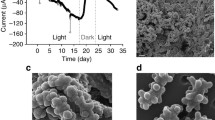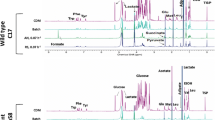Abstract
Endogenous and maximum respiration rates of nine purple sulfur bacterial strains were determined. Endogenous rates were below 10 nmol O2 · (mg protein · min)-1 for sulfur-free cells and 15–35 nmol O2 · (mg protein · min)-1 for cells containg intracellular sulfur globules. With sulfide as electron-donating substrate respiration rates were considerably higher than with thiosulfate. Maximum respiration rates of Thiocystis violacea 2711 and Thiorhodovibrio winogradskyi SSP1 (254.8 and 264.2 nmol O2 · (mg protein · min)-1, respectively) are similar to those of aerobic bacteria. Biphasic respiration curves were obtained for sulfur-free cells of Thiocystis violacea 2711 and Chromatium vinosum 2811. In Thiocystis violacea the rapid and incomplete oxidation of thiosulfate was five times faster than the oxidation of stored sulfur. A high affinity of the respiratoty system for oxygen (K m =0.3–0.9 μM O2, V max=260 nmol O2 · (mg protein · min)-1 with sulfide as substrate, K m =0.6–2.4 μM O2, V max=14–40 nmol O2 · (mg protein · min)-1 with thiosulfate as substrate), for sulfide (K m =0.47 μM, V max=650 nmol H2S · (mg protein × min)-1, and for thiosulfate (K m =5–6 μM, V max =24–72 nmol S2O 2-3 · (mg protein · min)-1 was obtained for different strains. Respiration of Thiocystis violacea was inhibited by very low concentrations of NaCN (K i =1.7 μM) while CO concentrations of up to 300 μM were not inhibitory. The capacity for chemotrophic growth of six species was studied in continuous culture at oxygen concentrations of 11 to 67 μM. Thiocystis violacea 2711, Amoebobacter roseus 6611, Thiocapsa roseopersicina 6311 and Thiorhodovibrio winogradskyi SSP1 were able to grow chemotrophically with thiosulfate/acetate or sulfide/acetate. Chromatium vinosum 2811 and Amoebobacter purpureus ML1 failed to grow under these conditions. During shift from phototrophic to chemotrophic conditions intracellular sulfur and carbohydrate accumulated transiently inside the cells. During chemotrophic growth bacteriochlorophyll a was below the detection limit.
Similar content being viewed by others
References
Beeftink HH, Gemerden Hvan (1979) Actual and potential rates of substrate oxidation and product formation in continuous cultures of Chromatium vinosum. Arch Microbiol 121: 161–167
Bogorov LV (1974) Properties of Thiocapsa roseopersicina, strain BBS, isolated from a White Sea estuary. Mikrobiologiya 43: 326–332
Cline JD (1969) Spectrophotometric determination of hydrogen sulfide in natural waters. Limnol Oceanogr 14: 454–458
Cypionka H, Meyer O (1982) Influence of carbon monoxide on growth and respiration of carboxydobacteria and other aerobic organisms. FEMS Microbiol Lett 15: 209–214
Cypionka H, Reijnders WNM, Wielink JEvan, Oltmann LF, Stouthamer AH (1985) Half reduction potentials and oxygen affinities of the cytochromes of Pseudomonas carboxydovorans. FEMS Microbiol Lett 27: 189–193
Dahl C, Trüper HG (1989) Comparative enzymology of sulfite oxidation in Thiocapsa roseopersicina strains 6311, M1 and BBS under chemotrophic and phototrophic conditions. Z Naturforsch 44c: 617–622
Eisenthal R, Cornish-Bowden A (1974) The direct linear plot. A new graphical procedure for estimating enzyme kinetic parameters Biochem J 139: 715–720
Gemerden Hvan, Tughan CS, Wit Rde, Herbert RA (1989) Laminated microbial ecosystems on sheltered beaches in Scapa Flow, Orkney Islands. FEMS Microbiol Ecol 62: 87–102
Gorlenko VM (1974) Oxidation of thiosulfate by Amoebobacter roseus in the dark under microaerophilic conditions. Mikrobiologiya 43: 729–731
Harder W, Dijken JPvan (1976) Theoretical considerations on the relation between energy production and growth of methaneutilizing bacteria. In: Schlegel HG, Gottschalk G, Pfennig N (eds) Symposium on microbial production and utilization of gases (H2, CH4, CO). E Goltze KG, Göttingen, FRG, p 403–418
Hartree EF (1972) Determination of protein: a modification of the LOWRY-method that gives a linear photometric response. Anal Biochem 48: 422–427
Herbert D, Elsworth R, Telling RC (1956) The continuous culture of bacteria, a theoretical and experimental study. J Gen Microbiol 14: 601–622
Herbert D, Phipps PJ, Strange RE (1971) Chemical analysis of microbial cells. In: Norris J, Ribbons DW (eds) Methods in microbiology, vol 5B. Academic Press, London, pp 209–344
Hurlbert RE (1967) Effect of oxygen on viability and substrate utilization in Chromatium. J Bacteriol 93: 1346–1352
Kämpf C, Pfennig N (1980) Capacity of Chromatiaceae for chemotrophic growth. Specific respiration rates of Thiocystis violacea and Chromatium vinosum. Arch Microbiol 127: 125–135
Kämpf C, Pfennig N (1986) Chemoautotrophic growth of Thiocystis violacea, Chromatium gracile and C. vinosum in the dark at various O2-concentrations. J Basic Microbiol 26: 517–531
Kelly DP, Chambers LA, Trudinger PA (1969) Cyanolysis and spectrophotometric estimation of trithionate in mixture with thiosulfate and tetrathionate. Anal Chem 41: 898–901
Kondratieva EN, Petushkova YuP, Zhukov VG (1975) Growth and oxidation of sulfur compounds by Thiocapsa roseopersicina in darkness. Mikrobiologiya 44: 389–394
Kondratieva EN, Zhukov VG, Ivanovsky RN, Petushkova YuP, Monosov EZ (1976) The capacity of photosynthetic sulfur bacterium Thiocapsa roseopersicina for chemosynthesis. Arch Microbiol 108: 287–292
Overmann J, Beatty JT, Hall KJ, Pfennig N, Northeote TG (1991) Characterization of a dense, purple sulfur bacterial layer in a meromictic salt lake. Limnol Oceanogr 36: 846–859
Overmann J, Fischer U, Pfennig N (1992) Thiorhodovibrio winogradskyi gen. nov. sp. nov., a new purple sulfur bacterium from saline littoral sediments. Arch Microbiol (in press)
Pfennig N (1971) Dark growth of phototrophic bacteria under microaerophilic conditions. J Gen Microbiol 61: ii-iii
Pfennig N (1989) Ecology of phototrophic purple and green bacteria. In: Schlegel HG, Bowien B (eds) Autotrophic bacteria. Springer, Berlin Heidelberg New York, pp 97–116
Richaud P, Marrs BL, Vermeglio A (1986) Two modes of interaction between photosynthetic and respiratory electron chains in whole cells of Rhodopseudomonas capsulata. Biochim Biophys Acta 850: 256–263
Scherer S (1990) Do photosynthetic and respiratory electron transport chains share redox proteins? Trends Biochem Sci 15: 458–462
Schink B, Pfennig N (1982) Fermentation of trihydroxybenzenes by Pelobacter acidigallici gen. nov. sp. nov., a new strictly anaerobic, non-sporeforming bacterium. Arch Microbiol 133: 195–201
Smith AJ, Lascelles J (1966) Thiosulphate metabolism and rhodanese in Chromatium vinosum sp. strain D. J Gen Microbiol 42: 357–370
Steenbergen CLM, Korthals HJ (1982) Distribution of phototrophic microorganisms in the anaerobic and microaerophilic strata of Lake Vechten (The Netherlands). Pigment analysis and role in primary production. Limnol Oceanogr 27: 883–895
Taylor BF, Hood TA, Pope LA (1989) Assay of sulfur as triphenyl-phosphine sulfide by high performance liquid chromatography: application to studies of sulfur bioproduction and sulfur in marine sediments. J Microbiol Methods: 221–231
Trüper HG (1964) Sulphur metabolism in Thiorhodaceae. II. Stoichiometry relationship of CO2-fixation to oxidation of hydrogen sulphide and intracellular sulphur in Chromatium okenii. Antonie Van Leeuwenhoek 30: 385–394
Trüper HG (1984) Phototrophic bacteria and their sulfur metabolism In: Müller A, Krebs B (eds) Sulfur, its significance for chemistry, for the geo-, bio-, and cosmosphere and technology. Studies in inorganic chemistry, vol 5. Elsevier, Amsterdam, pp 367–382
Wit Rde, Gemerden Hvan (1987) Chemolithotrophic growth of the phototrophic sulfur bacterium Thiocapsa roseopersicina. FEMS Microbiol Ecol 45: 117–126
Wit Rde, Gemerden Hvan (1990a) Growth of the photoautotrophic purple sulfur bacterium Thiocapsa roseopersicina under oxic/anoxic regimens in the light. FEMS Microbiol Ecol 73: 69–76
Wit Rde, Gemerden Hvan (1990b) Growth and metabolism of the purple sulfur bacterium Thiocapsa roseopersicina under combined light/dark and oxic/anoxic regimens. Arch Microbiol 154: 459–464
Venturoli G, Fenoll C, Zannoni D (1987) On the mechanism of respiratory and photosynthetic electron transfer in Rhodospirillum rubrum. Biochim Biophys Acta 892: 172–184
Visscher PT, Nijburg JW, Gemerden Hvan (1990) Polysulfide utilization by Thiocapsa roseopersicina. Arch Microbiol 155: 75–81
Zannoni D, Fuller RC (1988) Functional and spectral characterization of the respiratory chain of Chloroflexus aurantiacus grown in the dark under oxygen-saturated conditions. Arch Microbiol 150: 368–373
Author information
Authors and Affiliations
Rights and permissions
About this article
Cite this article
Overmann, J., Pfennig, N. Continuous chemotrophic growth and respiration of Chromatiaceae species at low oxygen concentrations. Arch. Microbiol. 158, 59–67 (1992). https://doi.org/10.1007/BF00249067
Received:
Accepted:
Issue Date:
DOI: https://doi.org/10.1007/BF00249067




